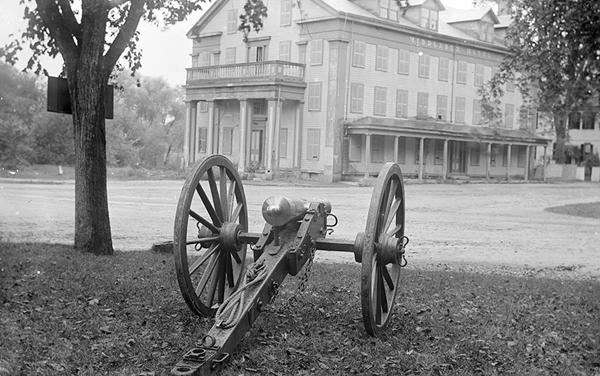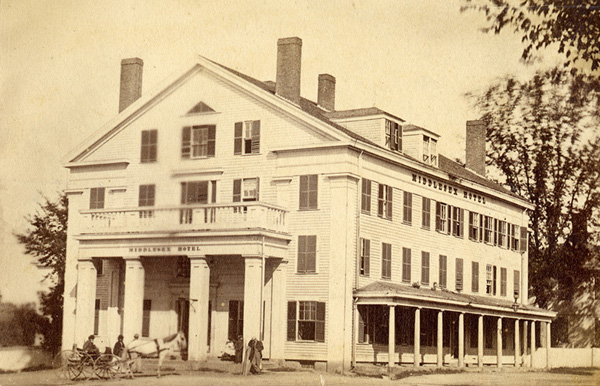The Middlesex Hotel—once located at the corner of Main Street and Monument Square, opposite the Wright Tavern—thrived as a center of county and town life for decades during the nineteenth century. It provided food, drink, and lodging for lawyers, litigants, and witnesses on court days while Concord was still a shire town, and served up meals to the prisoners in the county jail behind what was then the County House and is now the Catholic rectory. Out-of-town attendants of the Middlesex Agricultural Society’s annual fall Cattle Show lodged and dined there. Workers in the shops on Concord’s Mill Dam stopped in for a quick drink during their day. The hotel accommodated large dinners and dances, including the lavish military balls of the Concord Artillery, and a local dancing school held sessions there summer and winter. The place offered rest and refreshment to teamsters hauling loads over long distances, and food and drink (paid for by the Town of Concord) to selectmen and other local officials who met in the Middlesex to transact municipal business. It was also a stop for passenger and mail stages before the coming of the railroad in 1844 led to the decline of the stagecoach as a form of transportation.
Baker and hotelkeeper John Richardson came to Concord in the late 1770s and either constructed a new building or (as suggested by the research of Concord historian Ruth Robinson Wheeler) enlarged an existing one that ultimately became the Catholic rectory. He soon exchanged that building, in which he had kept a tavern, and some land behind it to Middlesex County for the next property south, then owned by the county. The tavern that he traded became the new County House, where jailers and sheriffs lived, and the property behind it was used for a stone county jail—no longer standing—over which Richardson was appointed the original jailer, and in which Henry David Thoreau spent one night in the summer of 1846. Richardson expanded the former county building on the lot closer to the Mill Dam (now Main Street) into the successful operation eventually known as the Middlesex Hotel.
The old Dr. Timothy Minot House and the adjacent county-owned building that Richardson acquired and renovated stood on property that in the seventeenth century had belonged to the Reverend Peter Bulkeley—a founder and the first minister of Concord—and where the retroactive purchase of Concord land by English settlers from the Native Americans was signed in 1637. Questions remain about the chronology and details of the removal of the Minot House, which is clearly visible in Amos Doolittle’s depiction of the Monument Square area in 1775, just a few years before John Richardson came to Concord.
The entrepreneurial Richardson was involved in multiple business ventures, including the tannery on the Mill Dam, and owned a number of hotels and stables in Massachusetts and New Hampshire. His early Middlesex Hotel was a three-story structure, featuring a barroom (heated by a big stove), large dining room, private dining rooms and parlors, and kitchen on the first floor, a public room on the second (a favorite resort for town officials), and a dance hall (complete with dressing room) occupying a full half of the third. The main access to Richardson’s building was at its rounded southeast corner. A porch along the first floor shows in John Warner Barber’s engraving of Monument Square as it looked in 1839.
Richardson operated the hotel himself for a time, then placed it in the care of a series of managers (Major Paine, Tilly Buttrick, Colonel Simonds, and finally Ebenezer Thompson). He moved away from Concord in the first decade of the nineteenth century. Thompson occupied and operated the place for about ten years prior to its sale by Richardson in the mid-1820s. Under Thompson’s management, it was referred to as Thompson’s Hotel.
In 1825, Richardson sold the hotel to Thomas D. Wesson and Gershom Fay, who ran it together for a few years. Fay then sold his interest to Wesson, a genial and well-liked man who, during the hotel’s heyday (1825-1845), clashed with local people only over the temperance issue, which for part of his ownership necessitated his operating in conflict with regulations. In 1839, Sam Staples (Thoreau’s jailer in 1846) married Wesson’s daughter Lucinda. Staples was barkeeper in and, for a while, manager of Wesson’s establishment. Colonel John Wilson was the resident manager at the time of the 1845 fire.
The original Middlesex Hotel burned on Tuesday, June 10, 1845. Although the stable and surrounding buildings were spared, the hotel itself was destroyed. Against the advice of those who understood that times were changing, Wesson insisted on rebuilding a new hotel on the location of, and similar to, the one that had gone up in flames. The major changes were the moving of the main entrance from the southeast corner to the center of the south side (facing the Mill Dam), the relocation of the dance hall to the north end of the building and the fitting of it with a spring floor, and some alterations to the porch configuration. In constructing a porch on the east side, Wesson used remnants of the cornerstone of an unfinished monument to the Concord Fight placed on the common in 1825.
The reopening of the Middlesex Hotel was celebrated with a ball on April 20, 1846. Despite his optimism, Wesson was unable to make a success of the new place. The convenience and speed of railroad travel decimated business, as did the loss to Lowell by the late 1840s of two terms (April and September) of the Court of Common Pleas. (The remaining courts were removed from Concord in 1867.) Wesson chose the ill-suited Colburn Hadlock to manage his new hotel. From its reopening until its final closing in the early 1880s, the Middlesex passed through a rapid succession of owners—among them Heman Newton and a partner in 1854, Marshall Davis and George W. Todd, later a Boston liquor merchant (so described by John Shepard Keyes), Abel G. and Julia Heywood, and finally, in 1875, George Heywood (who obtained the place by foreclosing on the mortgage)—and of managers and business proprietors—Ashley and Doton after Hadlock, then Doton alone, Samuel A. Hartshorn, William Wood, and James W. Jacobs, who ran the hotel until it closed its doors for good in 1882.

Toward the end of the Middlesex Hotel’s operation, the town added to the problems of the place by its unwillingness to allow the serving of liquor there. The coup de grāce was delivered in 1881, when the Middlesex suffered another major fire that destroyed its stable and threatened to ignite the tinderbox of the hotel itself, which was saved only by the vigorous exertions of firefighters.
Following the downward spiral of its final thirty-plus years of operation, the abandoned Middlesex Hotel stood a decaying hulk in Concord Center for nearly two decades. Finally, in 1900, four community-oriented Concordians (Stedman Buttrick, Edward Waldo Emerson, Richard F. Barrett, and Prescott Keyes) bought it and sold it to the Town of Concord. The site was designated for municipal purposes as part of the town’s celebration of the 125th anniversary of the Concord Fight, and the building was finally demolished.
The old Middlesex Hotel location serves today as a memorial park to honor Concordians who have died in wars from the 1940s on.

